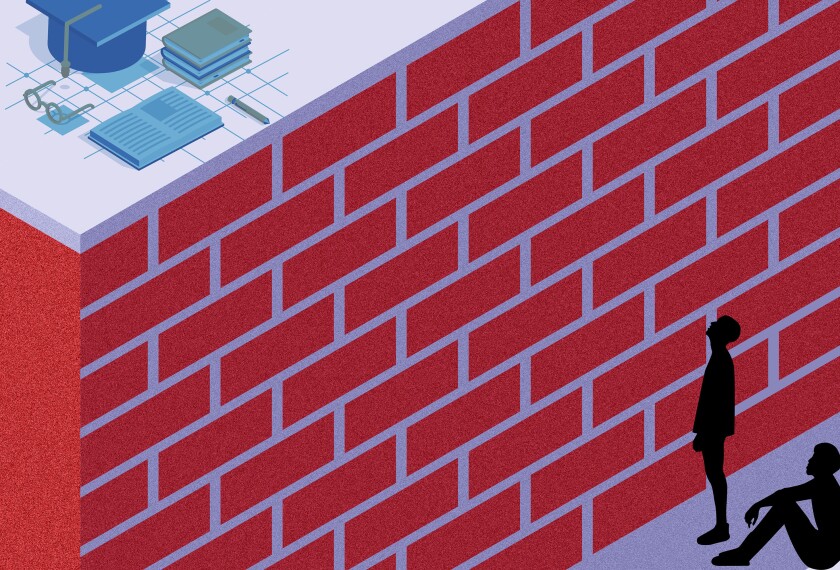The Black Lives Matter movement strengthened dramatically this year, as millions of Americans took to the streets to protest police violence. Schools have an opportunity to use this momentum and movement to reimagine their curriculum and teaching. Rather than returning to normalcy after the COVID-19 pandemic—to stale, dated, predetermined, irrelevant, under-responsive, disconnected, and “racially neutral” curriculum and instructional practices that maintain a white-centric status quo—teachers have a renewed chance instead to address opportunity gaps in education.
During almost 20 years of research in schools and working with teachers, I have found that teachers’ mindsets can have a profound impact on gaps of opportunity. When teachers adopt a “colorblind” mindset to their work—where their curriculum, instructional, relational, and assessment practices do not acknowledge, honor, and build on students’ racial identity—they create gaps in opportunity. Moreover, when “colorblindness” guides educational practice, teachers do not recognize systemic and institutional patterns, such as a disproportionate number of Black students who are suspended and expelled or referred to special education.
Opportunity gaps also increase when teachers do not recognize when their own culture and cultural practices conflict with the cultures of their students, families, and communities. Teachers who believe that they have rightfully earned their privileges through merit because they have worked hard, followed the law, or have skill and ability often do not recognize how those pathways to privilege are not available to everyone.
Opportunity gaps also intensify when teachers have deficit mindsets and low expectations of students of a particular race or background. These deficit mindsets show up in conversations teachers have with colleagues about students and families, their reading of students’ school records, and their generalized, misinformed stereotypes of particular students, especially Black and brown students. When teachers adopt context-neutral mindsets, they have a difficult time understanding why they need to study the spaces, places, and overall environments of students and their families. Opportunity gaps increase when teachers consider themselves the only—or the main—arbiters of knowledge and knowing, ignoring the enormous range of expertise, insights, and brilliance in local and broader contexts.
For the curriculum to converge with student experiences, teachers should focus on the 'so what?' of learning opportunities.
I have found that “opportunity-centered teaching” can address and disrupt aforementioned opportunity gaps and simultaneously build curriculum and instructional practices that advance a national push for racial reckoning. This approach places opportunity at the core of a classroom where teachers, students, parents, families, and communities recognize students’ diverse and dynamic assets. This involves designing instructional practices to hook students into content that connects with core aspects of their identities, such as their race, gender, and language.
What do teachers need to know and do to construct these practices in this race-reckoning movement in society? I have identified five interconnected imperatives for this work: Focus on building and sustaining relationships with students and families. Use community knowledge to inform practice. Protect the psychological and mental health of both students and teachers. Confront how racist, sexist, homophobic, xenophobic, and other beliefs inform our decisions. And, finally, prioritize curriculum and instructional convergence.
For the curriculum to converge with student experiences, teachers should focus on the “so what?” of learning opportunities just as they are concerned with what and how they teach. I have found that young people, and Black students in particular, spend too many hours in classrooms disconnected from anything that meaningfully resonates or connects with them. Curriculum convergence merges the who (student identity), the what (community and society as texts), and the where (inside and outside of school engagement of young people).
Teachers must help young people imagine how what they are learning might be a tool for something greater than themselves, and a race reckoning to improve the overall human condition is a fertile opportunity. When students can apply what they are learning for the greater good, social action and activism become an important form of curriculum and instruction.
Teachers should find ways to center questions of race, racism, and inequality in the curriculum. Discuss, for instance, the alarming and disproportionate number of deaths of Black and brown people from COVID-19. Talk openly about the police shootings of Black people, including Breonna Taylor, George Floyd, Rekia Boyd, and Antwon Rose Jr. Study the ongoing national immigration debates over children being taken from their families and placed in fenced cages, hundreds of whom still remain separated from their parents today. Research the long-running water crisis in Flint, Mich., as well as the many other crises of environmental justice across the United States and beyond.
This sort of curriculum and instructional convergence allows young people to think about themselves, their own families, and social injustices. This ultimately helps them to build their own positions on the need for and their participation in the racial reckoning our country is facing—and hopefully realizing and actualizing.
Curriculum and instruction can converge as opportunities for students to learn by bridging student identity, their practices, and engagement inside school with those outside of school, including their community experiences, insights, understandings, and realities. In other words, student identities and society must be considered curricular resources, centering students’ opportunities to learn. Their practices and interests become part of the curriculum that can be used as tools for social change.
There has never been a better time for opportunity-centered teaching that supports young people to build knowledge to improve racial relations and concurrently the human condition.




